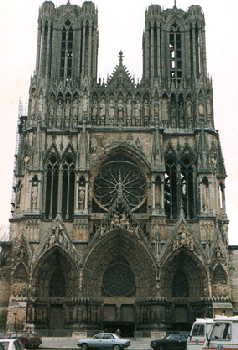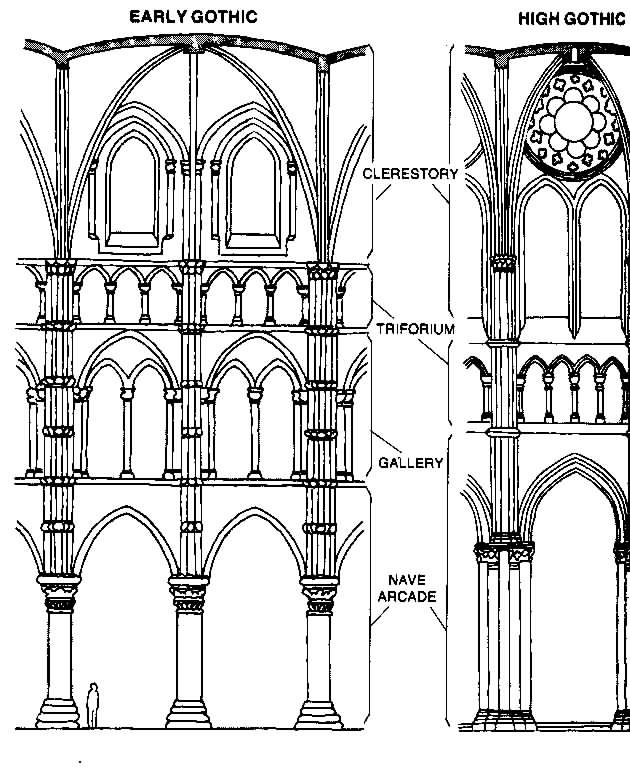Gothic Synopsis:
Gothic art emerged in France, near Paris, and from there spread across Europe.
"Elegant, soaring, light-filled interiors were adapted to all structures..."
(Stokstad, 234). The Abbey Church of Saint Denis is one of the first examples
of Gothic architecture, combining the new elements to create an open, flowing
space. Emphasis was on height and larger interior space, and the use of colored
glass in large window openings. Notre-Dame at Chartres is an example of early
and high Gothic styles. The creation of the pointed arch and the groined vault
allowed for greater height in these churches. The triforium, an open level between
the main floor and the clerestory, was introduced. Tall, pointed arched windows
called lancets filled the open spaces in the clerestory.
Notre-Dame at Reims is an example of High Gothic, using bar tracery to maximize
the amount of glass. The cathedral is richly decorated with sculpture on all
levels of the facade. Sculpture is executed in both Classical (naturalistic)
and Gothic (elongated figures, delicate features, restrained gestures) styles.
The Rayonnant style, the highest development of bar tracery, is exemplified
at Sainte-Chapelle. Castles at this time moved from simple strongholds to "elaborate
fortified residential complexes" (Stokstad, 243). Outside of France cathedral
builders were less concerned with height, focusing instead on long, broad naves
and wall decorations.
Independant sculpture grew in importance as individuals wanted small statues
for their homes or to donate to churches. The graceful S-curve pose was a stylistic
standard for this period. Private prayer books, called a Book of Hours, were
also popular. The Hours of Jeanne d'Evreux, by Jean Pucelle, are executed in
grisaille, monochromatic painting in shades of gray with touches of color. The
patron was often included in the religious scene. The figures are influenced
by sculptural styles, with soft modeling covering elegantly curved figures.
Pictorial needlework (Englishwork) was executed as precisely as painting.
Panel painting, especially on altarpieces, was important in Italy. Duccio combined
Byzantine and northern Gothic styles for his altarpiece, known as the Maesta,
at the Siena Cathedral. In Florence Cimabue executed the Virgin and Child Enthroned,
employing Byzantine formulas for the proportions. Giotto, pupil of Cimabue,
shared his "concern for spatial volumes, solid forms, and warmly naturalistic
human figures" but uses light and shadow to create a sense of spatial depth
and modeling. The Arena Chapel at Padua contains a set of frescoes that emplify
these sculpturally modeled figures and a sense of depth in the landscape. Sienese
painting would eventually lead to developments in Renaissance art.
Source: http://www2.students.sbc.edu/hill00/seniorseminar/summary5.html
Gothic Art
Gothic Art 1140 - 1500
TERMS
Transverse ribs
Jamb Statues
Rose Windows
Annunciation
Flying Buttress
Lancet Windows
Tracery
Visitation
Rederos - screen behind the High Altar
Reliquary - ornate box to hold relics
Chancel -
SLIDES

Ambulatory, Abbey Church of Saint Denis, 1140 - 1144 (photo by Leo Masuda)
Chartres
Cathedral, France, 1135
West Facade. Royal Portal & Jamb Statues
South Transept portal Jamb Statues
Notre-Dame, Paris, France 1163
 Reims Cathedral, Reims,
France, 1225 - 1290 (Photo by Leo Masuda)
Reims Cathedral, Reims,
France, 1225 - 1290 (Photo by Leo Masuda)
Annunciation and Visitation, Jamb Statues
Sainte-Chapelle, Paris France, 1243 - 1248 - High
Gothic: royal chapel and storehouse for relics, gold embellishment, compound
columns, pointed arches, ribbed vaulting, 6400 s.f. stained glass
Psalter of Saint Louis, from Paris, France, Ink, tempera and gold leaf on vellum
1253 - 1270
Salisbury Cathedral, Salisbury / England, 1220 - 1258, west facade completed
1265, Spire 1320-30 - smaller Westworks towers that
crossing tower, English trait
Death of the Virgin, tympanum of south transept, Strasbourg Cathedral, Strasbourg,
France 1230
Virgin with the Dead Christ, from the Rhineland, Germany, painted wood, ca.
1300- 1325
Milan Cathedral, Milan, Italy, begun 1386.
Links:
Gothic glossary (on this site)
http://www.cootech.disco.unimib.it/atelier/ontology/index.html (online)
IMAGES OF MEDIEVAL ART AND ARCHITECTURE
by Alison Stones
http://www.pitt.edu/~medart/index.html
Online Reference Book for Medieval Studies
http://orb.rhodes.edu/
DJB Quick Notes:
DJB In-Depth Notes:

In this High Gothic illustration on the right, the gallery has been eliminated
in favor of higher nave arcade. (Laon on left; Chartes on right)

 Reims Cathedral, Reims,
France, 1225 - 1290 (Photo by Leo Masuda)
Reims Cathedral, Reims,
France, 1225 - 1290 (Photo by Leo Masuda)